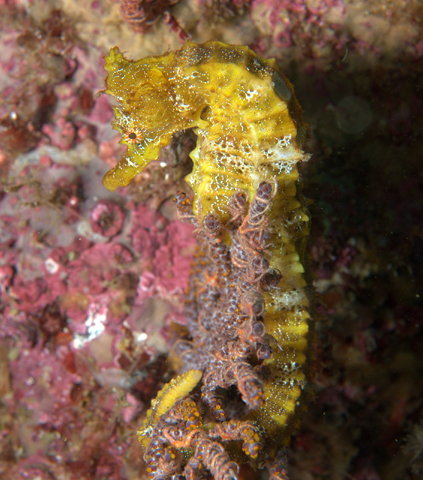| Syngnathidae (Pipefishes and seahorses), subfamily: Syngnathinae |
| 30 cm TL (male/unsexed) |
|
reef-associated; marine; depth range 0 - 60 m, non-migratory |
| Eastern Pacific: confirmed records from San Diego in California, USA to Peru including the Galapagos Islands.
Reported from the San Francisco Bay by Alexander Agassiz (Ron Fritzsche, pers.comm. 08/09). |
|
Dorsal spines (total): 0-0; Dorsal soft rays (total): 18-21. Description: (based on 19 specimens): Adult height: 13.0-19.0cm. Rings: 11+39 (38-40). Snout length: 2.3-2.4 (2.1-2.5) in head length. Dorsal fin rays: 19 (18-21) covering 2+1 rings. Pectoral fin rays: 16 (15-17). Coronet: medium-high, tilted backwards with five well-defined points, sharp edges or flanges at top. Spines: variable, from low rounded bumps to well-developed blunt-tipped spines. Other distinctive characters: prominent, long (drooping), rounded, single cheek spines; prominent eye spine (may be broad or almost double); males commonly have a prominent keel; sexually mature females often have a dark patch below the anal fin. Color pattern: reddish-maroon, grey, yellow and gold; various shades of brown; may have fine white light and dark markings running vertically down body. |
| Nocturnal. Occur in offshore waters, mostly captured by dredging at 10 m or deeper. Occasionally caught at surface. Are often camouflaged within the branches of gorgonians and black coral trees where they are seen to curl their tail around the branches (Ref. 5227). Have been found in the stomachs of Pacific yellowfin tuna and bluefin tuna (Ref. 30915). Ovoviviparous (Ref. 205). The male carries the eggs in a brood pouch which is found under the tail (Ref. 205). |
|
Vulnerable (VU); Date assessed: 05 December 2016 (A2cd) Ref. (130435)
|
| harmless |
Source and more info: www.fishbase.org. For personal, classroom, and other internal use only. Not for publication.

